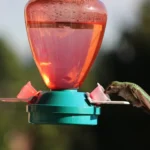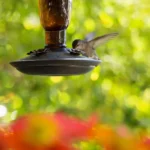You should clean your hummingbird feeder every 2-3 days in hot weather and every 4-5 days in cooler temperatures.
Keeping the feeder clean is essential for the health of the birds, as dirty feeders can harbor mold, bacteria, and spoiled nectar, which can make hummingbirds sick.
The frequency of cleaning depends on factors like the weather and how busy the feeder is, but regular maintenance is key to providing a safe feeding environment.
General Cleaning Guidelines
To keep your hummingbird feeder safe and healthy, it’s recommended to clean it every 2-3 days in hot weather (above 85°F).
The heat causes nectar to spoil quickly, which can lead to mold and bacteria growth that is harmful to the birds.
In cooler temperatures (below 85°F), cleaning the feeder every 4-5 days is usually sufficient.
During peak hummingbird season, when more birds are visiting, it’s especially important to clean the feeder frequently, as increased activity can speed up nectar spoilage.
Regular cleaning helps ensure that the feeder remains a safe and inviting spot for hummingbirds, free from harmful contaminants.
Signs Your Feeder Needs Cleaning
Several signs indicate it’s time to clean your hummingbird feeder. If you notice cloudy nectar, it means the nectar has started to spoil and should be replaced immediately.
Additionally, the appearance of mold or black spots on the feeder is a clear sign that bacteria or fungi are present. Dead insects around the feeder also suggest the need for cleaning, as they can contaminate the nectar.
Finally, a foul or fermented smell indicates that the nectar has gone bad, making it unsafe for hummingbirds. Cleaning the feeder regularly when these signs appear ensures a healthy feeding environment for the birds.
Step-by-Step Cleaning Process
Cleaning your hummingbird feeder regularly is crucial to keeping it safe for the birds. Here’s a simple step-by-step process:
- Empty any leftover nectar: Pour out any remaining nectar to avoid contamination from old, spoiled liquid.
- Wash the feeder with warm water and mild soap: Use warm water and a mild dish soap or a mixture of water and vinegar (1 part vinegar to 4 parts water). Avoid using harsh chemicals.
- Use a bottle brush for hard-to-reach areas: Scrub the feeder, especially the small ports and interior areas where mold and residue can build up. A bottle brush or small toothbrush is useful for this.
- Rinse thoroughly: After scrubbing, rinse the feeder with clean water to ensure all soap or vinegar residue is removed. Any leftover residue can harm the birds.
- Avoid bleach or harsh chemicals: Bleach or other strong cleaners can leave harmful residue that could endanger the hummingbirds.
By following this easy process, you can maintain a clean and safe feeder that hummingbirds will enjoy visiting regularly.
How to Deep Clean the Feeder
Deep cleaning your hummingbird feeder is essential if you notice mold, black spots, or a buildup of residue. To deep clean, use a solution of 1 part vinegar to 4 parts water.
Allow the feeder to soak for a few hours in this mixture to break down mold and any stuck-on grime.
After soaking, use a bottle brush to scrub the feeder thoroughly, paying special attention to the small feeding ports and hard-to-reach areas. Finally, rinse the feeder completely to remove any vinegar residue.
It’s recommended to deep clean your feeder once a month, but in humid conditions, where mold grows more quickly, you may need to clean it more frequently.
Regular deep cleaning helps ensure that your feeder stays hygienic and safe for hummingbirds to enjoy.
Why Regular Cleaning Is Important
Regular cleaning of your hummingbird feeder is crucial to prevent serious health risks for the birds.
Dirty feeders can harbor fungal infections and promote bacterial growth, which can cause illness or even death in hummingbirds.
Mold and spoiled nectar are particularly dangerous, as they can lead to digestive and respiratory issues.
By keeping your feeder clean, you provide a safe, inviting environment for hummingbirds, which encourages them to visit more often. Clean feeders not only attract more birds but also help maintain their health and well-being.
Consistent maintenance is key to ensuring that your feeder remains a reliable and healthy food source. Taking the time to clean the feeder regularly will support the birds’ health and keep them returning to your yard.
Tips to Keep Your Feeder Cleaner for Longer
To keep your hummingbird feeder cleaner for longer, consider placing it in a shaded area. Direct sunlight can cause the nectar to spoil quickly, and the shade will help slow down this process, keeping the nectar fresh for longer.
Choosing feeders with wide openings also makes a big difference. Wide openings allow for easier cleaning, helping you to reach all the surfaces and preventing mold and residue from building up.
Lastly, prepare smaller batches of nectar to avoid waste and reduce the need for frequent refills. By making just enough nectar to last a few days, you ensure that the feeder stays clean and fresh, encouraging hummingbirds to visit more regularly without the risk of spoilage.








